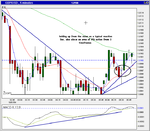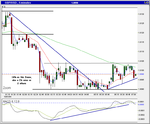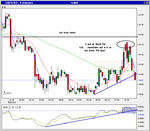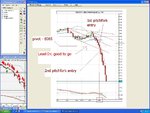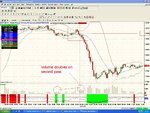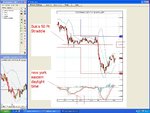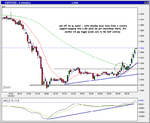You are using an out of date browser. It may not display this or other websites correctly.
You should upgrade or use an alternative browser.
You should upgrade or use an alternative browser.
😆 rofl........care to sling a few wads this way......I've dropped a major clanger a**** around before daylight hours 🙄
looks like this animal has broken loose & bolting for it's life today, you'll be tightening up the stirrups on this gallop no doubt?? 😉
looks like this animal has broken loose & bolting for it's life today, you'll be tightening up the stirrups on this gallop no doubt?? 😉
a classic case of 'a*** about face' this morning.....instead of waiting for the bigger picture to unfold, I thought I'd try & be clever & test the resistance/prev high. Got my a*** slapped & missed the easier ride south & a hatfull of pips! 😱
then it's a case of making work for yourself, attempting to catch half cocked rides on the back of a galloping wild thing 😈
more haste, less speed! 😢
then it's a case of making work for yourself, attempting to catch half cocked rides on the back of a galloping wild thing 😈
more haste, less speed! 😢
Attachments
Zenda
Well-known member
- Messages
- 491
- Likes
- 10
Buk said:a classic case of 'a*** about face' this morning.....instead of waiting for the bigger picture to unfold, I thought I'd try & be clever & test the resistance/prev high. Got my a*** slapped & missed the easier ride south & a hatfull of pips! 😱
then it's a case of making work for yourself, attempting to catch half cocked rides on the back of a galloping wild thing 😈
more haste, less speed! 😢
Buk After all the time we spent together I told you always look at the bigger picture 😱 Buy a dog and take it for a walk that is the answer! when you come back from the walk sometimes your stopped out and sometimes your "Pips Ahead" !!
Attachments
Retrospective
Hi Buko,
Times were good a year ago. Last Sept, Cable started the month at 1.57 and ended at 1.66. Not too shabby. This Sept, Cable started the month at 1.79 and ended at 1.79. A trend of another sort. (This year we have to work for our money!. In case we've forgotten last year's run peaked at 1.90 in Feb.) Some say the market will change after the election - we'll see - let's hope so. Is it possible to make money in this market? - why not?. Nimbleness helps!. Glad you brought up our old "Pivot" pal, because he has a different role to play in this market. Looking at last year's rising chart, he provided an excellent "limit entry" target, i.e., buy the dips. This year it's a better "stop entry" target, i.e., reversal point, as the marktet "pinballs" up and down. Today's action a good case in point. Cable opens 1.8132. Pivot 1.8065. Low 1.7928. Since your math is a little weak, that's 137 potential profit points post pivot break!
Moral - Get in and out fast / Strike while the iron is hot / Time and tide wait for no man / The early bird catches the worm / get there firstest with the mostest - Get my drift? (ha ha)
Also, Yen (both EUR & GBP) is the closest to a trending currency we have this year - but since you're a "cable guy," it's hard to ignore moves like today.
😈
Buk said:wondered where you'd got to (on here anyway :cheesy: ).....too much Calif sun & excessive pip collection no doubt!!.....keeping your eyes on those Pivots?? 😉
Hi Buko,
Times were good a year ago. Last Sept, Cable started the month at 1.57 and ended at 1.66. Not too shabby. This Sept, Cable started the month at 1.79 and ended at 1.79. A trend of another sort. (This year we have to work for our money!. In case we've forgotten last year's run peaked at 1.90 in Feb.) Some say the market will change after the election - we'll see - let's hope so. Is it possible to make money in this market? - why not?. Nimbleness helps!. Glad you brought up our old "Pivot" pal, because he has a different role to play in this market. Looking at last year's rising chart, he provided an excellent "limit entry" target, i.e., buy the dips. This year it's a better "stop entry" target, i.e., reversal point, as the marktet "pinballs" up and down. Today's action a good case in point. Cable opens 1.8132. Pivot 1.8065. Low 1.7928. Since your math is a little weak, that's 137 potential profit points post pivot break!
Moral - Get in and out fast / Strike while the iron is hot / Time and tide wait for no man / The early bird catches the worm / get there firstest with the mostest - Get my drift? (ha ha)
Also, Yen (both EUR & GBP) is the closest to a trending currency we have this year - but since you're a "cable guy," it's hard to ignore moves like today.
😈
Attachments
(This year we have to work for our money!.
you aint wrong there........and Mr Pivot is (as always) a trusted companion on the sometimes foggy & trecherous road 😉
good to see a few words from ya (on here)....say Hi to Jakemaven if you wander in there - I'll catch up with you on there in the not too distant 😀
ps : we won't talk about today thank you very much (ahhmmm) 😱
Last edited:
nine
Senior member
- Messages
- 2,049
- Likes
- 510
A question for Buk and noises49 and then a couple of statements.
Q. If, when you mention the pivot you mean the standard "yesterdays high, low and close" pivot point as calculated by floor traders, what open and close times (time zone aslo pretty please) do you use for the GBP/USD, the EUR/USD and the USD/JPY. I ask because I have tried to find good start and end times for currencies without visible success.
S1. It doesnt matter if 50% of decision points reverse vs carry on. The question for me is "at that point what is my risk/reward on a reversal trade vs a carry on trade?" This gives the true answer to whether I should trade trends or try for countertrend trades - it does change with higher timeframe market conditions.
S2. roguetrader on the top of page 4 raised the 50% up/50% down thingy and then extended it to suggest "risk 20 pips to make 100." There is one probability issue here: if you do a study of 10 pt vs 30pt moves from a random entry point you dont find that there is a 50% chance that it will go 10pts up vs 30pts down. The probability of going up 10 vs down 10 might well be 50% but its not 50% for unequal move sizes. Hmmmm ... very unclearly expressed, sorry, ... the point I am barely making is that the 50/50 rule is misleading because people apply it beyond its validity.
Q. If, when you mention the pivot you mean the standard "yesterdays high, low and close" pivot point as calculated by floor traders, what open and close times (time zone aslo pretty please) do you use for the GBP/USD, the EUR/USD and the USD/JPY. I ask because I have tried to find good start and end times for currencies without visible success.
S1. It doesnt matter if 50% of decision points reverse vs carry on. The question for me is "at that point what is my risk/reward on a reversal trade vs a carry on trade?" This gives the true answer to whether I should trade trends or try for countertrend trades - it does change with higher timeframe market conditions.
S2. roguetrader on the top of page 4 raised the 50% up/50% down thingy and then extended it to suggest "risk 20 pips to make 100." There is one probability issue here: if you do a study of 10 pt vs 30pt moves from a random entry point you dont find that there is a 50% chance that it will go 10pts up vs 30pts down. The probability of going up 10 vs down 10 might well be 50% but its not 50% for unequal move sizes. Hmmmm ... very unclearly expressed, sorry, ... the point I am barely making is that the 50/50 rule is misleading because people apply it beyond its validity.
FX Day ends/begins at 22:00 London time year round, or 22:00 GMT (standard time) and 21:00 GMT (daylight time). This is the point when interests on all accounts, worldwide, are updated. It is the only time that the FX community agrees on. Too bad; too many time zones to deal with. 24 Hr trading should only be quoted in GMT - the above is correct however.
Response to your statements:
I've been trying - for years - to find a fully automated/mechanical system to trade, w/o success. If you know of one, please let me know. I believe the "random walk" theory will beat you down in the end, i.e., for every big hit they produce, there will be ten small losers to nickel and dime you to death. Buk/'s got it right (As always). You've got to sit your ass down in front of the screen and trade the market. Sugardaddys don't exist here. The guys that predict where the market is going tomorrow are a huge joke. No one on the planet knowsI Forex is a space/time continuum. If we don't have a daily trend we'll have to drop to a lower time scale or take a year off and do some diving in Hawaii. In either case, it's forever interesting and challenging. Watching Cable plunge 200 pts at 3AM (my time) last night was a ball!
Response to your statements:
I've been trying - for years - to find a fully automated/mechanical system to trade, w/o success. If you know of one, please let me know. I believe the "random walk" theory will beat you down in the end, i.e., for every big hit they produce, there will be ten small losers to nickel and dime you to death. Buk/'s got it right (As always). You've got to sit your ass down in front of the screen and trade the market. Sugardaddys don't exist here. The guys that predict where the market is going tomorrow are a huge joke. No one on the planet knowsI Forex is a space/time continuum. If we don't have a daily trend we'll have to drop to a lower time scale or take a year off and do some diving in Hawaii. In either case, it's forever interesting and challenging. Watching Cable plunge 200 pts at 3AM (my time) last night was a ball!
nine
Senior member
- Messages
- 2,049
- Likes
- 510
So, let me make sure I understand you noises49. 22:00 london time corresponds to the close time of globex so you would set your open and close times to correspond with 22:00 london = 16:00 Chicago Time = 17:00 EST.
I have one mechanical system that trades currencies well EOD so I must try it out on 5 minute and 30 minute data to see if the same principles apply. My own short term approach is to buy/sell pullbacks in a trend, take half off on a close target, move the other stop up then trail pullbacks until stopped out. If I take a couple of losses in a row I stop until I am absolutely clear about the trend direction.
I have one mechanical system that trades currencies well EOD so I must try it out on 5 minute and 30 minute data to see if the same principles apply. My own short term approach is to buy/sell pullbacks in a trend, take half off on a close target, move the other stop up then trail pullbacks until stopped out. If I take a couple of losses in a row I stop until I am absolutely clear about the trend direction.
My own short term approach is to buy/sell pullbacks in a trend, take half off on a close target, move the other stop up then trail pullbacks until stopped out. If I take a couple of losses in a row I stop until I am absolutely clear about the trend direction.
then you have yourself a method of taking advantage of the intraday wiggles which occur all over the chart on a regular basis 😉 Noises made a comment a post or two back regarding the change in market behaviour from the past year or two?.....we've had recent info releases highlighting & confirming the rapid increase in Forex participation this year ,worldwide. I (as well as other regular players) began to notice a marked change in the behaviour of the pairs (Cable in particular) on swing runs up & down the ladder.
From around the end of first quarter, the chop increased around key levels, spikes increased markedly & inconsistancy (away from the century's) became common place.....the trend runs contracted & required tighter trade management. I guess one reason can be attributed to the 'hawking & sales pitch' from the shops/brokers, attracting folks in with "make your millions" garbage......folks trading styles (mostly short term/intraday) was bound to have an overall effect on the stability of price & I guess that's part of what we've witnessed thus far.
I have certainly had to re-evaluate my mid term strat outlook, and currently look to bank deals far sooner on the run than before. It's meant I now incorporate a combo approach. Initiating intraday plays off the fast frames, cashing out on next level tgts & trailing remainder with an eye on a longer run thru the (common) 50/00's when they break. Flexibility is key if you want to play these animals both short/mid term. Which is why the breakout strats have suffered greatly in this environment.
As Noises also pointed out......we've had to WORK for our money this year, and I don't see that changing in the short term......looking for statistical trend or mechanical approaches in this type of market is damned hard work & no doubt extremely frustrating, and if that's your barrow, then so be it......but until the mkt returns (if it ever will) to the trendy, leisurely punting days of recent times, it's a case of rolling up the sleeves, and getting your hands dirty!
should have added of course, that the previous (recent) two consolidations of any note (97 - 99 & late 2000 - 02) stretched out on a similar vein.....and given the free run experienced since the summer 02 b/o at 1.50, it's only to be expected that it pauses for breath!....as to where it goes? who knows, but when/if it does pop.....then maybe the trend followers will at last begin to get their own back 😈
Zenda
Well-known member
- Messages
- 491
- Likes
- 10
from Investica
Euro breaks resistance
US rates at 2.0% would help support the US currency as the yield gap over Euros would close and this would alleviate carry-trade dollar selling. While the expectations of a Fed rate hike are intact, the dollar will secure some protection. The underlying questions over US growth have not been answered over the past week. Immediate data should remain firm, but there will be growing concern over the implications of high oil costs. The US dollar will be vulnerable if the forthcoming data puts a November rate interest hike in jeopardy. The markets will aim to push the Euro higher after the break above important resistance this week, but there will still be barriers to strong Euro gains, especially with a substantial number of long speculative Euro positions.
US data releases:
ISM index manufacturing 58.5 Sep (59.0 Aug)
Consumer confidence 96.8 Sep (98.7 Aug)
Jobless claims 369,000 week ending Sep 24th (351,000 prev)
Market analysis
The dollar lost support at the 1.2350 level on Thursday and this pushed the dollar down to a low of 1.2435 before a slight rally to 1.24 in New York on Friday. The break above 1.2350 is potentially significant as the markets will try to push the Euro higher in the short term. There are, however, a substantial number of long Euro positions and this will make it difficult for the Euro to make further near-term progress.
The US data has been mixed and did not offer clear direction. Consumer confidence dipped to 96.8 in September from 98.7 in August and there was also a rise in jobless claims to 369,000 from 351,000 the previous week. The Chicago PMI index strengthened to 61.3 in September from 57.3 the previous month while the national PMI index dipped to 58.5 in September from 59.0 in August.
Oil prices have remained an important focus with prices pushing above the US$50 p/b level due to supply fears. There was a temporary decline after progress was reported in the Nigerian disputes, but prices ended above the US$50 level in New York for the first time. There are likely to be increased fears that US growth will be damaged by prices at this level. At this stage, the Fed is still on track to increase interest rates again in November to 2.0%. This would match the level of Euro rates and would help stem selling pressure on the US currency due to a reduction in carry trades. Disappointing US growth figures would, however, put this tightening in jeopardy and would also be likely to undermine the dollar.
Treasury bond yields dipped below the 4.0% level early in the week and, despite a rally in yields over the second half of the week, there has been evidence of a flow of funds into high-yield currencies. There have, for example, been significant gains for the Canadian and Australian dollars. Any signs of a pause in US tightening would maintain the flow of funds into high yields.
Euro breaks resistance
US rates at 2.0% would help support the US currency as the yield gap over Euros would close and this would alleviate carry-trade dollar selling. While the expectations of a Fed rate hike are intact, the dollar will secure some protection. The underlying questions over US growth have not been answered over the past week. Immediate data should remain firm, but there will be growing concern over the implications of high oil costs. The US dollar will be vulnerable if the forthcoming data puts a November rate interest hike in jeopardy. The markets will aim to push the Euro higher after the break above important resistance this week, but there will still be barriers to strong Euro gains, especially with a substantial number of long speculative Euro positions.
US data releases:
ISM index manufacturing 58.5 Sep (59.0 Aug)
Consumer confidence 96.8 Sep (98.7 Aug)
Jobless claims 369,000 week ending Sep 24th (351,000 prev)
Market analysis
The dollar lost support at the 1.2350 level on Thursday and this pushed the dollar down to a low of 1.2435 before a slight rally to 1.24 in New York on Friday. The break above 1.2350 is potentially significant as the markets will try to push the Euro higher in the short term. There are, however, a substantial number of long Euro positions and this will make it difficult for the Euro to make further near-term progress.
The US data has been mixed and did not offer clear direction. Consumer confidence dipped to 96.8 in September from 98.7 in August and there was also a rise in jobless claims to 369,000 from 351,000 the previous week. The Chicago PMI index strengthened to 61.3 in September from 57.3 the previous month while the national PMI index dipped to 58.5 in September from 59.0 in August.
Oil prices have remained an important focus with prices pushing above the US$50 p/b level due to supply fears. There was a temporary decline after progress was reported in the Nigerian disputes, but prices ended above the US$50 level in New York for the first time. There are likely to be increased fears that US growth will be damaged by prices at this level. At this stage, the Fed is still on track to increase interest rates again in November to 2.0%. This would match the level of Euro rates and would help stem selling pressure on the US currency due to a reduction in carry trades. Disappointing US growth figures would, however, put this tightening in jeopardy and would also be likely to undermine the dollar.
Treasury bond yields dipped below the 4.0% level early in the week and, despite a rally in yields over the second half of the week, there has been evidence of a flow of funds into high-yield currencies. There have, for example, been significant gains for the Canadian and Australian dollars. Any signs of a pause in US tightening would maintain the flow of funds into high yields.
Similar threads
- Article
Technical Analysis
The Four Most Commonly Used Indicators In Trend Trading
- Replies
- 6
- Views
- 13K
- Replies
- 0
- Views
- 3K

